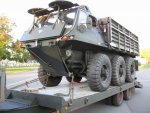- 1,046
- 47
- 48
- Location
- Syracuse, New York
When I got my metal coil endorsement NY State gave me a book on cargo securement. Here is the on-line version (I could not find anything from Indiana).
There is also other useful info in the link below (right click save target as...) including a chart with various chain sizes, types and WLL ratings (see page 2.7) and angles required when using direct tiedowns (page 2.13)
http://www.nydmv.state.ny.us/forms/mv79.pdf
New York requires that the securement system be capable of resisting a forward force of 80% cargo weight (.8G). As stalwart mentioned 3/8" grade70 (transport) has a WLL of 6,600lbs.If your load is 30,000lbs then 80% is 24,000 lbs. The rear chains (single string) must rate 12,000 lbs each so grade 80 1/2 inch chain would be the minimum acceptable chain (for the back). Additional lower grade/size/strings can do the job too (ex:- a pair of 3/8" grade 70 looped (double string) for 26,400lbs)
Chain marks may be embossed on every third or fourth link. The above link has a diagram of the marks.
Crossing chain is useful to increase the lateral angle. When you use outboard D rings and have narrow vehicle attachment points (as shown in your forward photo) you can, depending on the longitude angle, simply go directly to the nearest anchor avoiding crossed chains. You would want to cross chains in back using the vehicle anchor points shown and the narrow frame rails. The idea is to resist both motion to the side and fore/aft. If chains run longitudally they offer little resistance to sideways motion. If they run laterally the offer little resistance to fore/aft motion and other rigging may be required.
You may also want to check your tractor's rear axle weight when loaded and know the cargo height for low bridges. Check trailer tyre (British vehicle present) pressures often too.
Ratchet binders cost more but are better.
Your trailer needs some mudflaps.
Photo- non crossed, 3/8" grade 70 double string in front x2, non crossed 1/2" grade 70 single string in back x2. These rear chains have large safety hooks at each end. I attach them and drive forward. They fix the load in the same place every time. It's fast and very consistent so tongue and axle weights don't vary (this load is 95% or trailers rated capacity so location of weight is important). Mudflaps, a lockable lid added to utility tray so i don't get stranded if someone lifts some rigging at an event, (usually only used in NY.).
p.s. I welded on the four D rings being used because the ones that came with the trailer weren't in the best locations for my vehicle.
There is also other useful info in the link below (right click save target as...) including a chart with various chain sizes, types and WLL ratings (see page 2.7) and angles required when using direct tiedowns (page 2.13)
http://www.nydmv.state.ny.us/forms/mv79.pdf
New York requires that the securement system be capable of resisting a forward force of 80% cargo weight (.8G). As stalwart mentioned 3/8" grade70 (transport) has a WLL of 6,600lbs.If your load is 30,000lbs then 80% is 24,000 lbs. The rear chains (single string) must rate 12,000 lbs each so grade 80 1/2 inch chain would be the minimum acceptable chain (for the back). Additional lower grade/size/strings can do the job too (ex:- a pair of 3/8" grade 70 looped (double string) for 26,400lbs)
Chain marks may be embossed on every third or fourth link. The above link has a diagram of the marks.
Crossing chain is useful to increase the lateral angle. When you use outboard D rings and have narrow vehicle attachment points (as shown in your forward photo) you can, depending on the longitude angle, simply go directly to the nearest anchor avoiding crossed chains. You would want to cross chains in back using the vehicle anchor points shown and the narrow frame rails. The idea is to resist both motion to the side and fore/aft. If chains run longitudally they offer little resistance to sideways motion. If they run laterally the offer little resistance to fore/aft motion and other rigging may be required.
You may also want to check your tractor's rear axle weight when loaded and know the cargo height for low bridges. Check trailer tyre (British vehicle present) pressures often too.
Ratchet binders cost more but are better.
Your trailer needs some mudflaps.
Photo- non crossed, 3/8" grade 70 double string in front x2, non crossed 1/2" grade 70 single string in back x2. These rear chains have large safety hooks at each end. I attach them and drive forward. They fix the load in the same place every time. It's fast and very consistent so tongue and axle weights don't vary (this load is 95% or trailers rated capacity so location of weight is important). Mudflaps, a lockable lid added to utility tray so i don't get stranded if someone lifts some rigging at an event, (usually only used in NY.).
p.s. I welded on the four D rings being used because the ones that came with the trailer weren't in the best locations for my vehicle.
Attachments
-
74.6 KB Views: 43
Last edited:




 We will need pics and video!!!
We will need pics and video!!!